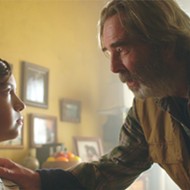SLO Film Fest reviews 3/8/18
[{
"name": "Ad - Medium Rectangle CC01 - 300x250",
"id": "AdMediumRectangleCC01300x250",
"class": "inlineCenter",
"insertPoint": "8",
"component": "2963441",
"requiredCountToDisplay": "12"
},{
"name": "Ad - Medium Rectangle LC01 - 300x250",
"id": "AdMediumRectangleCC01300x250",
"class": "inlineCenter",
"insertPoint": "18",
"component": "2963441",
"requiredCountToDisplay": "22"
},{
"name": "Ad - Medium Rectangle LC09 - 300x250",
"id": "AdMediumRectangleLC09300x250",
"class": "inlineCenter",
"insertPoint": "28",
"component": "3252660",
"requiredCountToDisplay": "32"
}]
For more show times and films, visit slofilmfest.org
ADVENTURES IN PUBLIC SCHOOL
What's it rated? NA
What's it worth? Full price
Where's it showing? March 15 at 1:15 and 9 p.m. at Downtown Centre
Pick
Kyle Rideout (Eadweard) directs this quirky heartwarmer, which he co-wrote with frequent collaborator and producer Josh Epstein. Newcomer Daniel Doheny plays Liam, a socially awkward teenager who has been homeschooled his entire life. Against the wishes of his protective mother, Claire (Judy Greer, Arrested Development, It's Always Sunny in Philadelphia), Liam pursues the possibility of attending a public high school for his senior year. Once enrolled, a girl named Anastasia (Siobhan Williams, Hell On Wheels, UnREAL, Heartland) catches his eye and soon becomes the object of his affection.
The general synopsis may sound a bit been-there-done-that, but Adventures in Public School (or Public Schooled as it's known in Canada, its country of origin) manages to divert the trappings of its own subgenre, in the same vein as Lady Bird and The Edge of Seventeen. The story follows a very familiar pattern we've come to know through other coming-of-age comedies, but approaches it from a fresh angle. And the closer the film comes to an end, the more it diverges from the beaten path. As you're watching, it's satisfying to see one prediction after another turn out wrong.
The characters that inhabit Adventures in Public School, however zany for comedic impact, feel like fully formed human beings. The overprotective, smothering mother archetype is as old as time itself, which makes Greer's performance and Rideout and Epstein's script all the more commendable. Claire's exchanges with Liam are layered with nuance. Wanting to keep Liam under her wing isn't Claire's objective simply because the plot demands it, rather her character does. Similarly, Williams' Anastasia could have just been a run-of-the-mill girl next door. This isn't the case, although her character ironically ends up living literally next door to Liam, unbeknownst to him until the second act.
The highest compliment I think I can pay Adventures in Public School is to dub it the Canadian Lady Bird of last year. Coincidentally, the directors behind both films are better known for their acting work. Putting an actor behind the camera might have been the best possible move, but the real star of Adventures in Public School is the script. It's refreshing to ponder the different directions the story could have gone in and realize it wasn't afraid of taking the road less traveled. (86 min.)
—Caleb Wiseblood
MAN ON FIRE
What's it rated? NA
What's it worth? Full Price
Where's it showing? March 15 at 1:45 and 9 p.m. at Downtown Centre
Pick
How far would you be willing to go to stand up for your beliefs?
This question lies at the heart of Man on Fire, a documentary about Charles Moore, a 79-year-old retired Methodist minister who committed suicide by setting himself on fire in the small Texas town of Grand Saline to protest racism perpetrated against black Americans.
The documentary mainly consists of interviews with Grand Saline residents as well as Moore's friends and family, but is interspersed with re-enactment footage of the moments leading up to Moore's horrific death by self-immolation in a parking lot. What we learn from the film is that the retired minister had long been a passionate proponent of racial equality and chose to kill himself to bring attention to the past sins of the town, which he felt had not properly atoned for its racist past.
The film, directed by Joel Fendelman, attempts to unpack not only the story behind Moore's death, but paints a portrait of the town he singled out. Grand Saline is a small town, and much of the film focuses on asking its residents to try and untangle fact from fiction when it comes to its past and present treatment of people of color. Some say the town has a long and storied history of racism, including keeping black Americans out of the city and even hanging them, while others question the veracity of such claims, which were the basis for Moore's very public act. Whatever side they end up on, it is very clear that many in Grand Saline are uncomfortable with the publicity Moore's death brought to their little town, and even more uncomfortable talking about the issue of race and racism and what role it may or may not have played in its history.
Regardless of how you feel about Moore's death, one can't help but see the country's struggle to come to terms with issues of race and racism, both in its past and in in its present, reflected though the residents of Grand Saline. Like the town's apologists, white Americans would like to believe that the country has moved on from its racist past, but as current events clearly show, that past is far less distant than we'd like to believe, and those old, deep wounds are far from healed.
Man on Fire asks us to ask ourselves some very hard questions, demanding not answers but at the very least a discussion that Americans, particularly white Americans, seem so reluctant to have. (54 min.)
—Chris McGuinness
PRINCE OF SMOKE
What's it rated? NA
What's it worth? Full Price
Where's it showing? March 14 at 4:30 p.m. at Downtown Centre
Pick
In 2010, the "godfather" of Cuban tobacco died at 91, but not before training his grandson to take over the tobacco business. Alejandro Robaina was considered a legend among Cuban tobacco growers, with his family farming tobacco since 1845. Now his grandson, Hirochi Robaina, is learning to overcome the challenges of having a tobacco farm in the documentary Prince of Smoke.
Hirochi's grandfather always knew that he would take the reigns of the family business. One day Hirochi was given a note from Alejandro that said, "Hirochi you are my hope; don't let me down."
Director Matthew Gelb follows Hirochi during the tobacco harvest season, which lasts a total of 60 days. In the field with his workers, Hirochi picks the leaves while they are still ripe, but bad weather can ruin the crop. The issue that Hirochi is facing is climate change.
"Cigars and wine are like cousins, they both depend on the climate, the land, and the grower," Hirochi said.
The legacy on Hirochi's shoulders is immense; Fidel Castro even gave his grandfather an award. The race against bad weather and struggle to maintain the high standards of a tobacco legend is an amazing story to watch unfold.
I'm left in awe of the people who work together to make this farm possible. Gelb did a fine job of capturing the importance of this business to a man and his family. (24 min.)
—Karen Garcia
A RIVER'S LAST CHANCE
What's it rated? NA
What's it worth? Full Price
Where's it showing? March 15 at 1:15 p.m. at The Palm
Pick
The Eel River watershed in Northern California is the third largest in the state and is home to one of the most abundant wild salmon populations on the West Coast. But it's also been one of the most heavily impacted and exploited watersheds. Filmmaker Shane Anderson tells us all about that history, what it means for the future, and why we should care in his poignant, no-frills documentary, A River's Last Chance.
Beginning in the Mendocino National Forest and flowing into the Pacific Ocean via Humboldt County, the Eel River watershed and its rich natural resources supported Native American communities before European settlers arrived and industrialized it for salmon and timber in the late 19th century. Using an eclectic mix of interview subjects and historical material, Anderson chronicles the exploits of the river basin over time and how that hurt the salmon population and generally disrupted the river's ecological balance. A wake-up call from Mother Earth arrived in 1964 with epic rains and floods that, because of the extensive redwood clear-cutting taking place in the watershed area, decimated riverside towns, infrastructure, and industries, and continued to affect the area's ecology.
Despite those impacts and others like the installation of the Pottery Valley dam, which diverts Eel River water to the Russian River to aid wine country growth; the cannabis "green rush"; and the 2011 to 2016 drought, Anderson shows how the river and its inhabitants still persist—but not without many painful sacrifices.
By tracking its history and history's lessons, A River's Last Chance tees up a challenge for the future: to live within the Eel River watershed more sustainably. Cannabis farmers, loggers, and state officials mulling the relicensing of the dam are all called out in the film as holding the health of the Eel River in their hands.
At a little more than an hour long, this documentary never drags, yet still offers tons of interesting insight from its informed subjects, ranging from biologists to politicians to cannabis growers. (67 min.) Δ
—Peter Johnson
Speaking of SLO Film Fest
-

The survivor: Film icon Pam Grier to attend the SLO Film Fest
Mar 15, 2018 -

Former SLOcals bring ballet to AT&T Stadium
Mar 15, 2018 -
SLO Film Fest reviews 3/15/18
Mar 15, 2018 - More »






